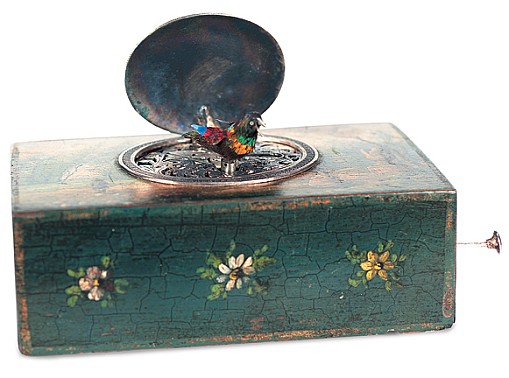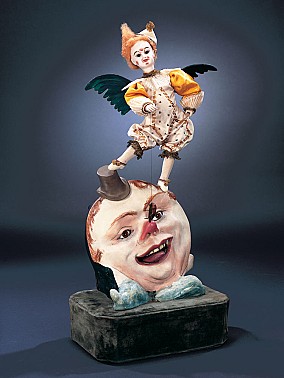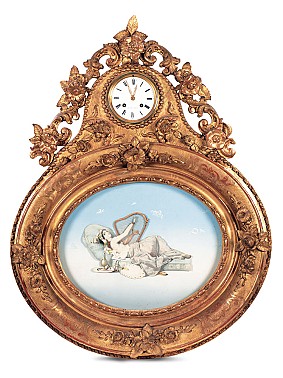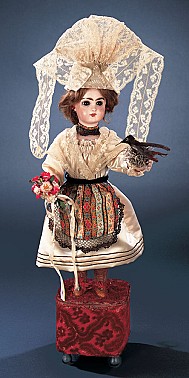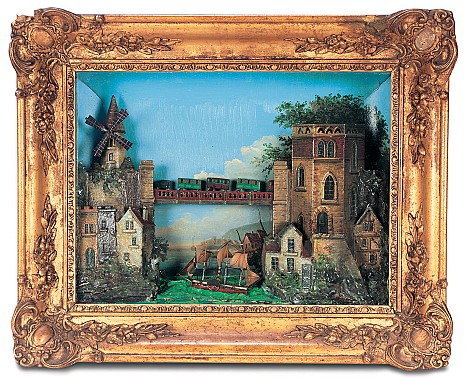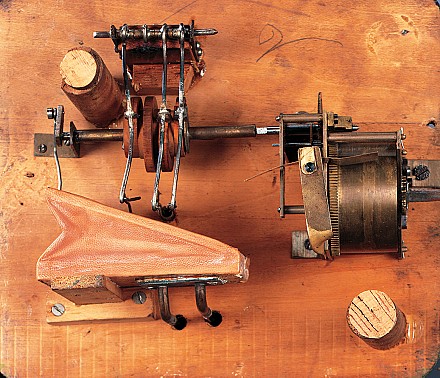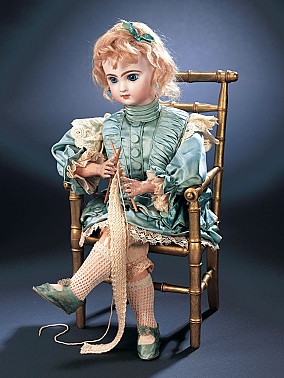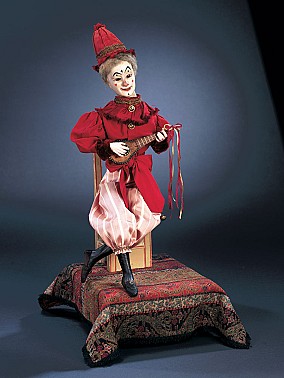16" House,"Scenes of Daily Life in Old Basel", The Mechanical House of Emil Wick
Lot #5
16" House, A three-story wooden residence or hotel particuliere, representing a typical edifice of Basel, Switzerland in the early 1800's is constructed with rich architectural details including shuttered windows mirrored for reflection of the exterior scenes and backed with old French-language paper, set-back columned porch on the third floor, extended columned porch on the ground floor with a balcony above, water pump, turrets, carved shingles, flag pole, chimneys, gable windows, and caretaker's attic apartment. The entire house is peopled in a manner designed to portray the active occupational and social life of Basel, circa 1810. Each of the people is of carved wood with superbly detailed carved and painted costumes and features.The ground floor represents the working class including six carpenters working in the shade of the porch, their carpentry tools arranged on the wall behind them, while nearby a woman draws water from the well pump, and at the other side of the house is a peg-legged Napoleonic war veteran with cane in one hand and hat in the other begging for a morsel of food from the woman who stands in the doorway.The second floor features a tavern scene peopled by soldiers in regimental uniforms sitting at tables alongside some village folks, apparently in an animated political discussion, while in the doorway calmly sits a woman at her spinning wheel. The third floor features six well-dressed waltzing couples and a three-person orchestra with instruments. There are other small vignettes that add to the sense of busy town life: dove birds in the chimney that move independently from each other but come together in a kiss, a chimney sweep that climbs in and out of the chimney, and a woman leaning in and out of the attic window as though to see what the hubbub is all about.There are, in all, 30 figures (counting the waltzing couple as one figure each, and including the doves) and every figure has mechanical animations; in addition, the "water" pours from the pump spout. The scene appears to be one of random activities because there are so many figures and they are animated at different times, but actually the movements are synchronized. Creative and complex strings, threads, pulleys, counter-balance weights, and cams provide the movement of the animated figures when wound.A two-tune miniature cylinder musical movement is wound from the front with a separate key. The musical movement is appropriate to the era, but may not be original as the tune-change lever indicates an original manual tune lever, and the existing cylinder is automatically changing. The house rests upon a beautifully grained fruitwood cabinet with three faux-drawers and brass escutcheon, and the house, itself, is enclosed in a lift-off glass cabinet of matching woods. The mechanisms of the house are visible from the glass-enclosed rear side. Historical References: Emil Wick of Basel, Switzerland, born in 1816, was raised in an affluent and artistic family. Educated and of a curious mind, he traveled throughout European art centers for many years, keen on escaping the monotony of only one profession. For a time he was apprenticed in horology, then he studied architecture, then the optician's art and then he became immersed in the development of the daguerreotype. Emil Wick is said to have had an acerbic view of life to which he had no hesitation in giving voice. Upon receiving a daguerreotype that Wick had produced of her, a society dowager asked if Wick could maker her look better. Wick replied, "Of course, of course, just let me photograph you from behind."This multi-faceted background and wry humor served him well. Upon returning to Basel toward the end of his busy life, he set about creating a mechanical masterpiece for each of his five godchildren. The five mechanical vignettes each depicted daily life in old Basel. With Wick's masterful eye toward architectural details and his mechanical skill at integrating a multitude of different actions, he created five houses and street scenes, each extraordinary in its details and workmanship, and insightful in its vision of daily life. Each is unique. And each is an extraordinary living document of early 19th century village life. The houses of Emil Wick and his fascinating history were documented in an entire chapter in the 1928 treatise, Le Monde des Automates, by Chapuis and Gelis. The authors summed up the man's work in a sentence that is truly ironic, considering Wick's love of photography. The houses"...portray what photography can never render, that is animated life and emotions...each of these little actors playing his part, over and over again, …with good humor and patience." One of the houses, and its animations, was shown in an amazing 1928 documentary film, La Feerie des Automates. When Le Monde des Automates was written in 1928, the authors documented the location of all five pieces. Today, the whereabouts of three of the five houses is known, one at the Musee International d'Horlogerie in La Chaux-de-Fonds, Switzerland, one in a private collection in Paris, and this house, from the collection of Paul Gendre.












